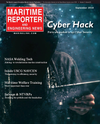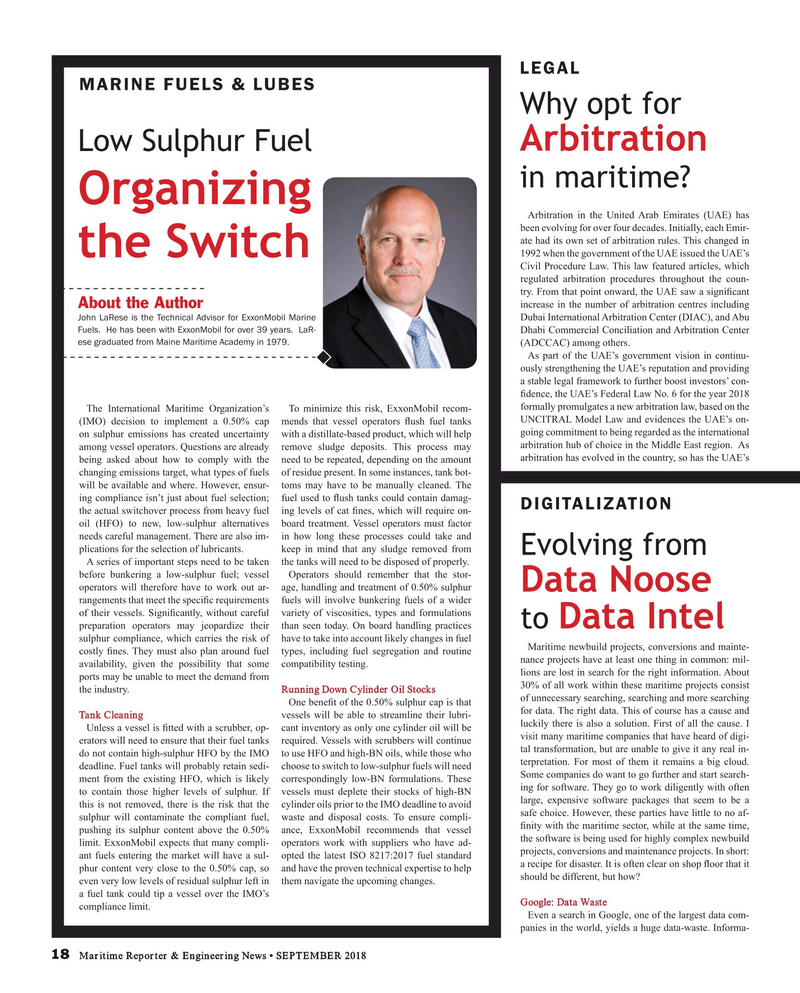
Page 18: of Maritime Reporter Magazine (September 2018)
Maritime Port & Ship Security
Read this page in Pdf, Flash or Html5 edition of September 2018 Maritime Reporter Magazine
LEGAL
MARINE FUELS & LUBES
Why opt for
Arbitration
Low Sulphur Fuel in maritime?
Organizing
Arbitration in the United Arab Emirates (UAE) has been evolving for over four decades. Initially, each Emir- ate had its own set of arbitration rules. This changed in 1992 when the government of the UAE issued the UAE’s the Switch
Civil Procedure Law. This law featured articles, which regulated arbitration procedures throughout the coun- try. From that point onward, the UAE saw a signi? cant increase in the number of arbitration centres including
About the Author
Dubai International Arbitration Center (DIAC), and Abu
John LaRese is the Technical Advisor for ExxonMobil Marine
Fuels. He has been with ExxonMobil for over 39 years. LaR-
Dhabi Commercial Conciliation and Arbitration Center ese graduated from Maine Maritime Academy in 1979.
(ADCCAC) among others.
As part of the UAE’s government vision in continu- ously strengthening the UAE’s reputation and providing a stable legal framework to further boost investors’ con- ? dence, the UAE’s Federal Law No. 6 for the year 2018 formally promulgates a new arbitration law, based on the
The International Maritime Organization’s To minimize this risk, ExxonMobil recom-
UNCITRAL Model Law and evidences the UAE’s on- (IMO) decision to implement a 0.50% cap mends that vessel operators ? ush fuel tanks going commitment to being regarded as the international on sulphur emissions has created uncertainty with a distillate-based product, which will help arbitration hub of choice in the Middle East region. As among vessel operators. Questions are already remove sludge deposits. This process may arbitration has evolved in the country, so has the UAE’s being asked about how to comply with the need to be repeated, depending on the amount changing emissions target, what types of fuels of residue present. In some instances, tank bot- will be available and where. However, ensur- toms may have to be manually cleaned. The ing compliance isn’t just about fuel selection; fuel used to ? ush tanks could contain damag-
DIGITALIZATION the actual switchover process from heavy fuel ing levels of cat ? nes, which will require on- oil (HFO) to new, low-sulphur alternatives board treatment. Vessel operators must factor needs careful management. There are also im- in how long these processes could take and plications for the selection of lubricants. keep in mind that any sludge removed from
Evolving from
A series of important steps need to be taken the tanks will need to be disposed of properly. before bunkering a low-sulphur fuel; vessel Operators should remember that the stor- operators will therefore have to work out ar- age, handling and treatment of 0.50% sulphur
Data Noose rangements that meet the speci? c requirements fuels will involve bunkering fuels of a wider of their vessels. Signi? cantly, without careful variety of viscosities, types and formulations to Data Intel preparation operators may jeopardize their than seen today. On board handling practices sulphur compliance, which carries the risk of have to take into account likely changes in fuel
Maritime newbuild projects, conversions and mainte- costly ? nes. They must also plan around fuel types, including fuel segregation and routine nance projects have at least one thing in common: mil- availability, given the possibility that some compatibility testing.
lions are lost in search for the right information. About ports may be unable to meet the demand from 30% of all work within these maritime projects consist the industry. Running Down Cylinder Oil Stocks of unnecessary searching, searching and more searching
One bene? t of the 0.50% sulphur cap is that for data. The right data. This of course has a cause and
Tank Cleaning vessels will be able to streamline their lubri- luckily there is also a solution. First of all the cause. I
Unless a vessel is ? tted with a scrubber, op- cant inventory as only one cylinder oil will be visit many maritime companies that have heard of digi- erators will need to ensure that their fuel tanks required. Vessels with scrubbers will continue tal transformation, but are unable to give it any real in- do not contain high-sulphur HFO by the IMO to use HFO and high-BN oils, while those who terpretation. For most of them it remains a big cloud. deadline. Fuel tanks will probably retain sedi- choose to switch to low-sulphur fuels will need
Some companies do want to go further and start search- ment from the existing HFO, which is likely correspondingly low-BN formulations. These ing for software. They go to work diligently with often to contain those higher levels of sulphur. If vessels must deplete their stocks of high-BN large, expensive software packages that seem to be a this is not removed, there is the risk that the cylinder oils prior to the IMO deadline to avoid safe choice. However, these parties have little to no af- sulphur will contaminate the compliant fuel, waste and disposal costs. To ensure compli- ? nity with the maritime sector, while at the same time, pushing its sulphur content above the 0.50% ance, ExxonMobil recommends that vessel the software is being used for highly complex newbuild limit. ExxonMobil expects that many compli- operators work with suppliers who have ad- projects, conversions and maintenance projects. In short: ant fuels entering the market will have a sul- opted the latest ISO 8217:2017 fuel standard a recipe for disaster. It is often clear on shop ? oor that it phur content very close to the 0.50% cap, so and have the proven technical expertise to help should be different, but how? even very low levels of residual sulphur left in them navigate the upcoming changes. a fuel tank could tip a vessel over the IMO’s
Google: Data Waste compliance limit.
Even a search in Google, one of the largest data com- panies in the world, yields a huge data-waste. Informa- 18 Maritime Reporter & Engineering News • SEPTEMBER 2018
MR #9 (18-25).indd 18 MR #9 (18-25).indd 18 9/5/2018 11:20:46 AM9/5/2018 11:20:46 AM

 17
17

 19
19
